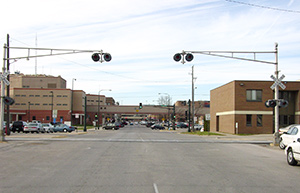ABOUT HIGHWAY-RAILROAD CROSSINGS
A highway-railroad grade crossing is an intersection where a roadway crosses railroad tracks at the same level. Iowa’s transportation system includes approximately 4470 public crossings and 3400 private crossings. In 2005, there were a total of 77 crashes at highway-railroad crossings, with the vast majority (70) occurring at public crossings.
Because a grade crossing is a point at which more than one mode of transportation meets several public and private entities, both entities have jurisdiction over various aspects of the intersections.
Railroad companies own and maintain the tracks, and generally own the property to either side of the tracks. At a limited number of crossings, the railroad property is owned by an entity other than a traditional railroad company (for example, an industrial spur owned by a manufacturer or a siding owned by an agricultural cooperative.) In issues related to highway-railroad crossings, these other owners are considered a railroad. At grade crossings, the owner generally installs and maintains the tracks, the roadway surface between and around the rails, and traffic control devices on their rights of way.
While the railroad owns the track, the roadway at a crossing is owned by either a public or private entity. Public crossings are those at which the highway or roadway is under the jurisdiction of and maintained by a public authority such as a city, county or state. Private crossings are those in which the roadway is privately owned, as you might find on a farm or within an industrial complex, where the road is not intended for public use. The roadway owner, whether public or private, typically maintains the road approaching the crossing on either side of the tracks. The Iowa DOT maintains programs that only apply to public, not private, crossings.
The Federal Highway Administration (FHWA) is responsible for public grade crossing issues affecting highway safety. FHWA provides guidelines and standards for the correct design of grade crossings and appropriate placement of traffic control devices at and on the approach to a grade crossing, such as circular advance warning signs, crossbucks, pavement markings, etc. Part 8 of the Manual on Uniform Traffic Devices (MUTCD), published by the Federal Highway Administration, contains guidance on traffic control at highway-railroad crossings.
The Federal Railroad Administration (FRA) regulates the aspects of grade crossing safety pertaining specifically to the railroads such as track safety, train-activated warning devices and train safety and conspicuity. This includes issues such as lighting on locomotives, train horns and inspection, testing, and maintenance standards for grade crossing signal safety.

A safety improvement at a public highway-railroad crossing can be proposed by either the entity that has jurisdiction over the highway or roadway (city, county or state) or the railroad. Because both parties have a vested interest, both the highway authority and the railroad must agree on any improvement, including the type of improvement and the cost that will be borne by each party.
Either the highway authority or the railroad (or other owner) can initiate an application for funding to assist with the cost of the safety improvements at public crossings. Funding sources administered by the Office of Rail Transportation include:
Federal funds authorized in Title 23 Unites States Code (23 USC. section 130 (which are called “Section 130 funds”) and most recently reauthorized in Safe, Accountable, Flexible, Efficient Transportation Equity Act: A Legacy for Users (SAFETEA-LU).
- Specifically for eliminating hazards at public highway-railroad grade crossings.
- Cannot be spent on safety improvements at private rail crossings.
- FHWA distributes the Section 130 funds, and the Iowa DOT’s Rail Transportation Bureau administers those funds.
- In 2006, Iowa received $4.2 million in Section 130 funds.
State funds from the Road Use Tax Fund
- $900,000 specifically for surface improvements at highway-railroad crossings.
- $700,000 specifically to assist with maintenance costs of signals.
- Administered by the Iowa DOT’s Rail Transportation Bureau.
- Cannot be used for safety improvements at private rail crossing.
State funds from the Primary Road Fund
- Specifically to assist with surface improvements at highway-railroad crossings on the Primary Road System, amount varies with needs.
- Administered by the Iowa DOT’s Rail Transportation Bureau.
A proposed improvement can proceed without funding if the parties involved negotiate an agreement on the type of improvement and cost sharing. However, railroads and highway or roadway jurisdictions are encouraged to apply for funding to assist with safety improvements.